TWO EUROPEAN IMPERIAL BEER BEAKERS: THE STORY BEHIND “THE AUSTRIAN IMPERIAL BEAKER.”
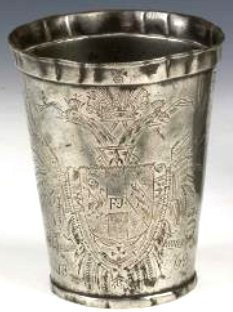
This 5 inch tall heavily engraved pewter beaker is called “The Austrian Imperial Beaker” (Or the “Maundy Thursday” Beaker). [WFTD] They were presentation pewter beakers from the Emperor / Empress of Austria, given to the 12 oldest men and women in the City of Vienna on the Thursday before Good Friday = “Maundy Thursday” each year.
AS the Austrian Kings claimed to be the end of the line of the Holy Roman Emperor and used the double headed eagle in their State arms; some might call this a Holy Roman Emperor’s beaker. Most historians of course would not agree – but worse things have been wrongly called within the steon collector’s circle!
This beaker’s maker’s mark is” “C NEBBIEN” – “S:W: FEINZIN” and is double stamped on the bottom of the beaker. Of course there were many different Master pewter-smith’s marks over the years.
This beaker presentation was after Franz Josef washed the old people’s feet! The Emperors of Austria believed they were the descendants of the Holy Roman Empire (HRE), and as Christianity was the HRE’s religion, this was symbolic of Jesus washing the feet of his disciples. The belief of being the HRE is also shown by the adoption of the double headed eagle standard, started by Charlemagne.
.
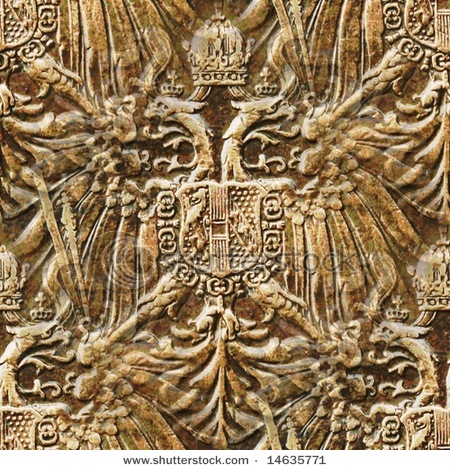
Comps of above:
These beakers are engraved with the royal arms and the year of the presentation at the bottom. On both sides of the Eagle at the top are the initials ” FJ – AI -HBR- AA”, meaning: ” Franz Josef” – “Emperor Austria” – “Hungary/ Bohemia Rex” – “Arch Duke, Austria.” THis one ias dated 1853
The Emperor also gave the old women 24 gold coins and the men 12 (I guess because they weren’t going to live as long = ?) This custom started with Maria Theresa so there were lots of a few of these made, but not many still out there.
There are not many of these shown in the US literature. I found my first reference in the book titled “National Types of Old Pewter” [a revised and expanded edition by Howare Herschel Cotterell, Adolphe Riff and Robert M. Vetter. The book was published by Weathervane Books, New York in 1972.] This beaker might be rated a 5 (Uncommon ) on the Smith-Paratore rarity scale.
Update 3-4-2o13:
There was a recent offering on eBay for two of these beakers. What made them of sincere interest to me is that both were initialed (named) for the ruling Empress at the time, and not the Emperor.
.
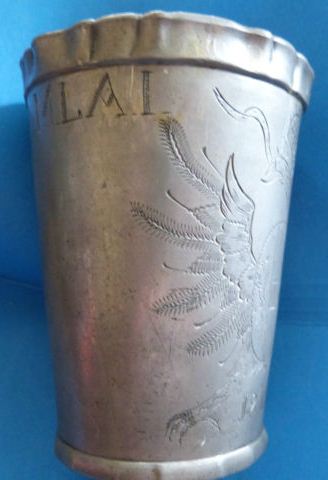
,
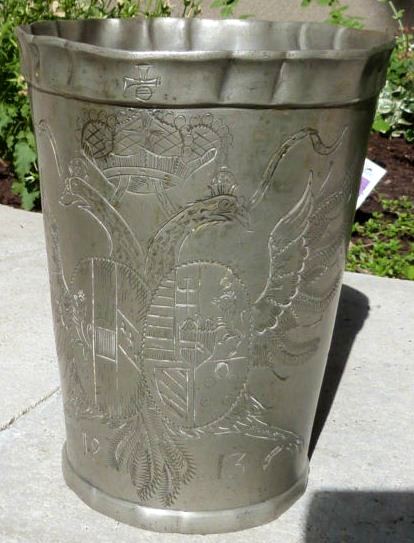
The first shown, initialed (MLIA) was from Empress Maria Ludovika and dated 1813. This one has her Coat of Arms engraved next to the Imperial Eagle. All four photos are courtesy of eBay’s “nancywoodqa”
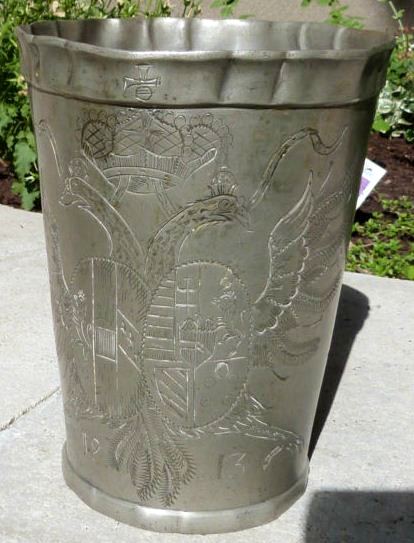
Detail of Empress Maria Ludovika arm’s.
.
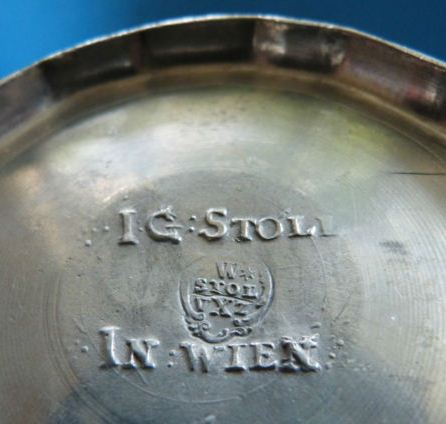
A very unusual Maker’s mark, molded relief and not stamped.
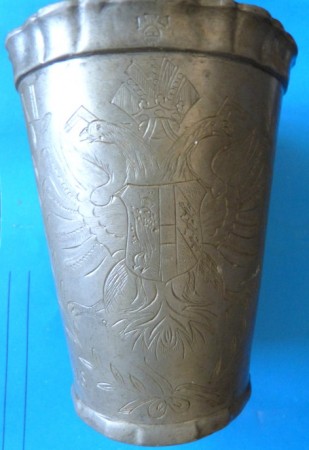
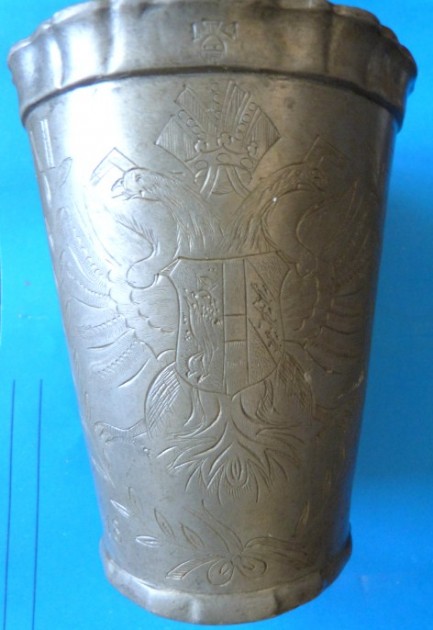
1861 is the date on this pewter beaker and it is initialed: EAI HBRAA = Empress Elizabeth François.
She was the mother of queens and a daughter to an Archduke and a sister to yet another queen. Born in 1831, she had six children from 1855 to 1864, with her second husband, her first cousin Archduke Karl Ferdinand of Austria. .
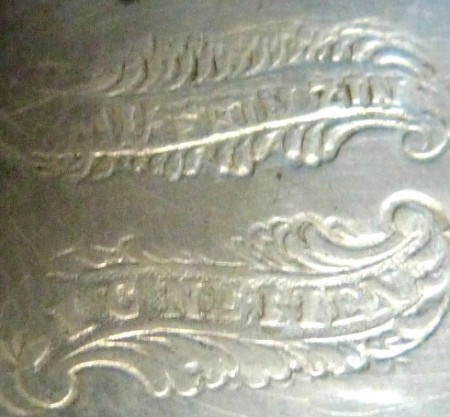
Detail of the maker’s mark, same pewterer as on the Emperor’s beaker, done in 1853, far above.
The three photos above courtesy of eBay’s “nancywoodqa“
These, indicate to me that both the royal members were involved in this ceremony, although I can’t picture the Empress(s) washing the old people’s feet.
THE STORY BEHIND “THE RUSSIAN IMPERIAL BEAKER.”
IT HAS BEEN CALLED “THE CUP OF TEARS”, “THE CUP OF SORROWS”, AND ALSO “THE BLOOD CUP.”
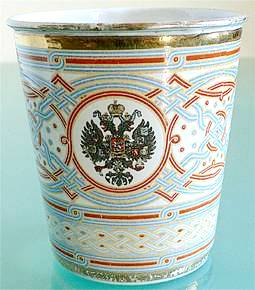
5 Inches tall. Baked enameled porcelain over tin. With a single Cypher of Nicholas and Alexandra. [FWTD]
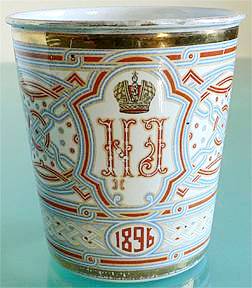
There are several stories out there in “www.land” about how exactly this cup got its name, etc. They all refer of course to the Coronation of Czar Nicholas II of Russia, for which occasion it was made. Only the details of the place the incident occurred and the number of dead varies.
I have chosen to take the information I wish to believe from the book: “RUSSIAN IMPERIAL STYLE” written by Laura Cerwinske, and produced (funded) by the world famous New York Jewelry firm “A La Vieille Russie.” This firm originated in Russia prior to the revolution, and has been supplying their wealthy clients with Russian art items for decades. Surely they would know the correct story! This is what is said on page 153; and shown on the bottom photo of that page:
“An 1896 enamel-and-copper “Coronation Cup” for the coronation of Nicholas II and Alexandra Fyodorovna, sometimes referred to as the “Cup of Sorrows.” They were distributed from the Imperial coronation train, and it was erroneously rumored that one contained a five ruble coin, causing a stampede that resulted in the death of hundreds of Russians.”
As stated earlier, other versions of this story abound; as in the note that was inside my cup when I purchased it: “Made in c. 1896 to commemorate the coronation of Czar Nicholas II of all Russians. This beaker has become known as the “Cup of Sorrow” or “Blood Cup” due to the horrendous disaster which occurred during the coronation celebrations. The Russian citizens were invited to attend the celebration at Khodinka Fields outside of Moscow. Women were given handkerchiefs and sweetmeats, the men sausage, beer and the beaker to drink the beer from. A rumor flew around the crowd that there were insufficient items for all present; in the stampede that followed more than 2000 people were trampled to death. This did not however deter the Czar from continuing with all the planned activities. Surely a sign of the times to come! This most sought after beaker is in exceptionally good condition considering it survived the Russian Revolution, 2 World Wars, and the fall of Communism.”
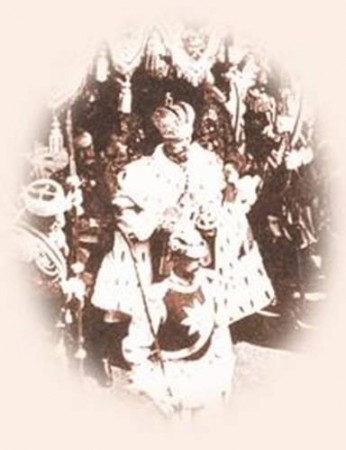
Nicholas II, Czar of Russia.
And here is yet another twist; from: www.alexautographs.com: “Fine relic from the coronation of Russian Tsar Nicholas II, the “Khodynka” cup, or “Cup of Sorrows” made to honor the event. The ceramic (sic) -covered copper cup measures 4” tall and 3 1/2” wide at top, bearing the crowned ciphers of Nicholas II and Tsarina Alexandra above the date “1896”. On the opposite side is the Russian Imperial double-headed eagle, with the balance of the cup bearing a rust and pale blue latticework design between gilt edgings at top and bottom. These cups were distributed to the public on the morning following the coronation, on a large military training field crossed with trenches and ditches. On that balmy day, a rumor shot through the crowd that there was a shortage of these mementos, and the crowd surged toward the distribution points, with many being trampled and crushed underfoot.”
I have been unable to ascertain the distributed total amount of these type coronation cups (there were other types made.) None of these are signed by the maker that I am aware of.
The price range varies widely, from $600.00 to $1500.00, even with essentially the same condition. The perfect ones are almost all in European Museums.
[END – SOK – 12 – 4D]
 “Experience is what you get when you didn’t get what you wanted.”
“Experience is what you get when you didn’t get what you wanted.”

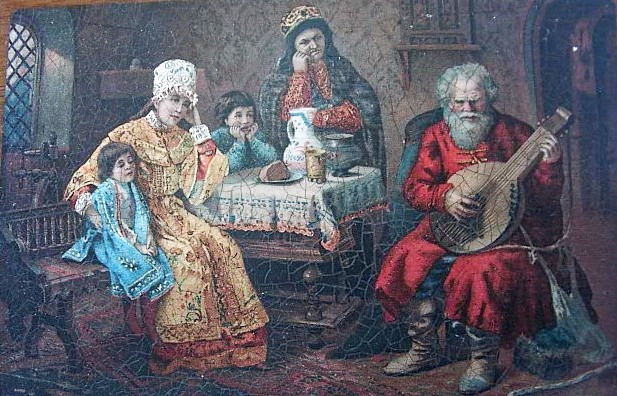

Leave a Reply